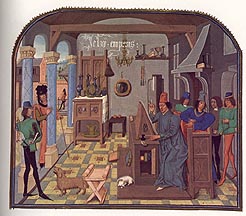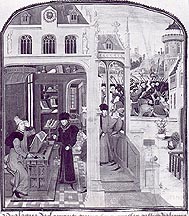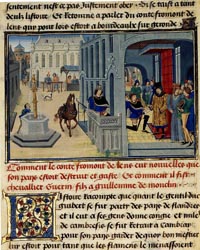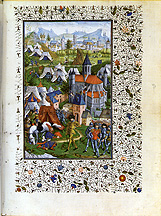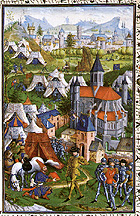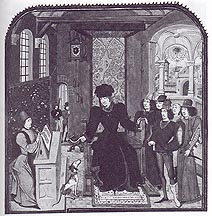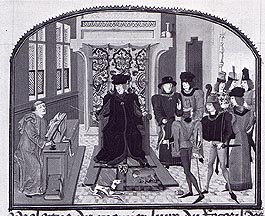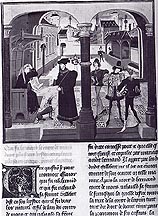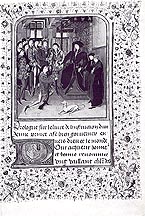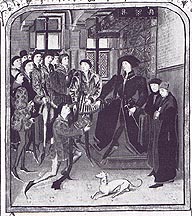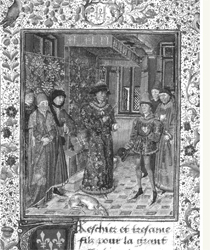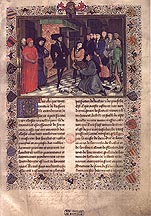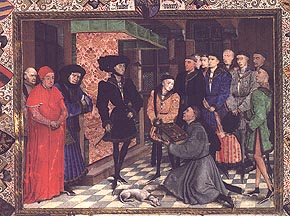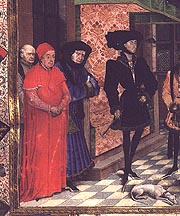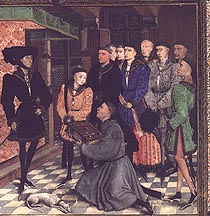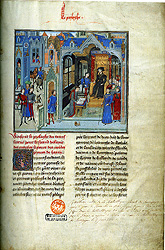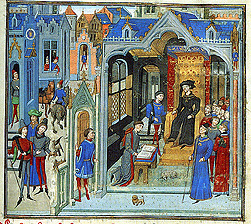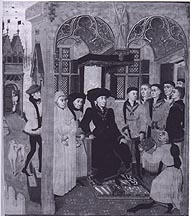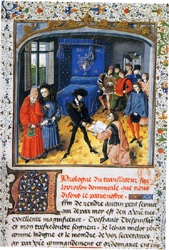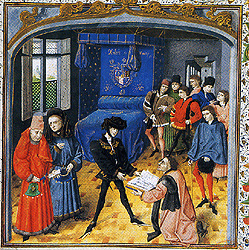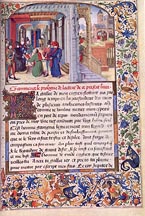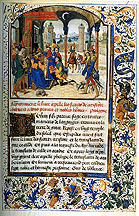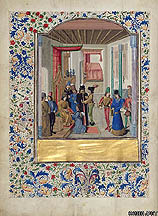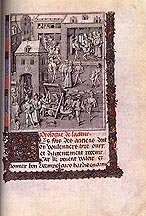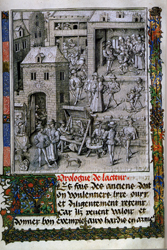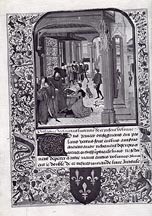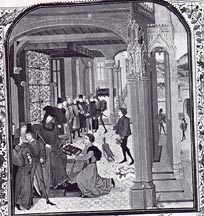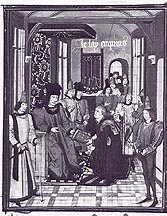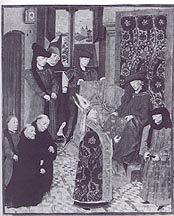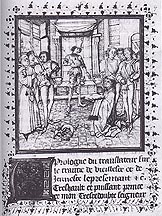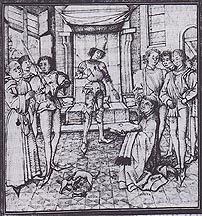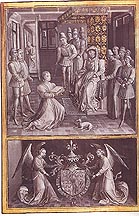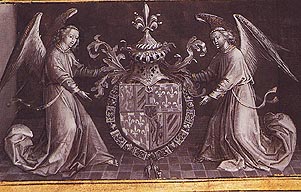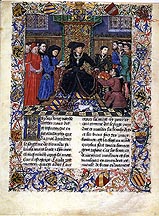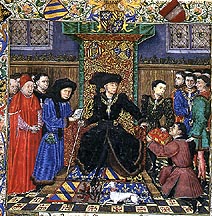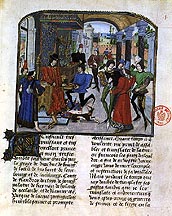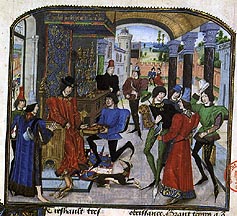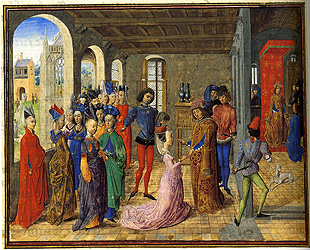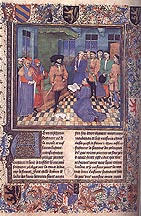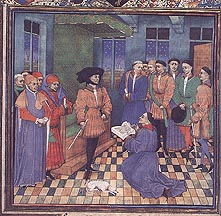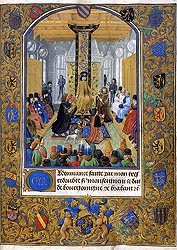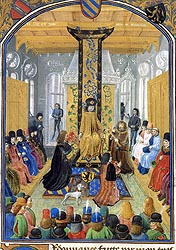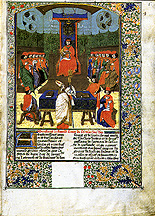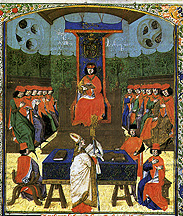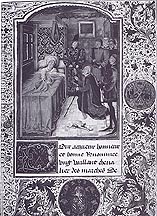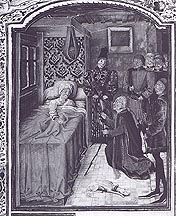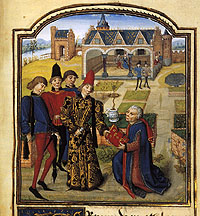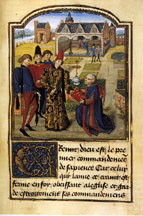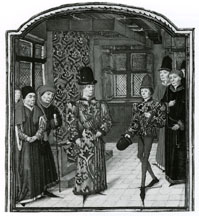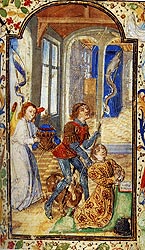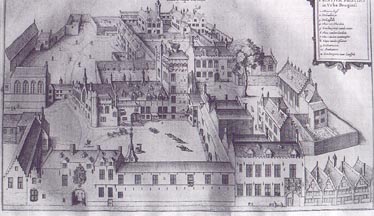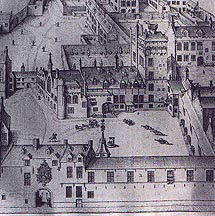| Fromont de Lens received News of the Devastation of his Lands, leaf cut from Histoire de Charles Martel |
| Los Angeles, Getty Museum |
| Bibliography: Illuminating the Renaissance, no. 55, pp. 231-233. |
| Brussels, Bibliothèque royale, ms. 10976 |
| Author: Guillebert de Lannoy |
| Title: Livre de l'Instruction d'un Jeune Prince |
| Artist: atelier of the Master of Guillebert de Lannoy (active in Brussels between 1450-60) |
|
Commentary: The format of this manuscript with 20 lines of text per page and its marginal decoration is similar to a group of manuscripts transcribed by Miélot between 1449 and 1454. The presentation miniature is closely akin to the comparable miniature in the first volume of the Chroniques de Hainaut (Brussels, B.R., 9242) |
| Bibliography: La Miniature Flamande, p. 139, no. 167. Dogaer, pp. 68-69. |
| Paris, Bibliothèque nationale, fr. 1 216, f. 76: Hugues de Lannoy, Les Enseignements paternels. |
| Bibliography: Bernhard Sterchi, "Hugues de Lannoy , auteur de l’Enseignement de vraie noblesse, de l’Instruction d’un jeune prince et des Enseignements paternels," |
|
Brussels,
Bibliothèque royale, ms 9243 |
| Author: Jacques de Guise |
| Title: Chroniques de Hainaut, vol. 2 |
| Translator: Jean Wauquelin |
| Artist: Guillaume Vrelant |
| Commentary: the miniature of folio 1 shows Wauquelin (?) reading from the Chronicle. Philippe le Bon is shown seated on a throne, while, standing to his right, is Charles de Charolais. Vrelant apparently did not paint this miniature until 1468 during the reign of Charles the Bald, but this miniature shows Charles as the same age as he was in the first volume (ms. 9242). |
|
Paris,
Bibliothèque nationale, fr. 9342, fol. 1
|
| Title: Roman d'Alexandre |
| Translator: Jean Wauquelin |
|
Commentary: The Roman d'Alexandre was produced by Jean Wauquelin along with the Roman de Girart de Roussillon and the Chroniques de Hainaut. All three of these texts include the arms of Philip the Good. The preface of the Chroniques de Hainaut records that Wauquelin had produced his translation of the Roman d'Alexandre in 1446 when he was still attached to Jean de Bourgogne the governor of Picardy. Wauquelin produced the translation of the Roman de Girart de Roussillon in 1447 for Philip the Good. |
| Bibliography: L.M.J. Delaissé, "Les 'Chroniques de Hainaut" et l'atelier de Jean Wauquelin a Mons, dans l'histoire de la miniature Flamande," Miscellanea Erwin Panofsky, Bulletin Musées Royaux des Beaux Arts, 1955, pp. 21-56. |
| Brussels, Bibliothèque royale, ms 9092 |
| Title: Traite sur l'Oraison Dominicale |
| Translator: Jean Miélot, completed in 1457 |
| Artist: attributed to Jean Le Tavernier |
| Bibliography: La Miniature Flamande, p. 89 no. 90. |
| Paris, Bibliothèque nationale, fr. 331 |
| Title: Histoire de la conquete de la Toison d'Or or Histoire de Jason |
| Scribe: attributed to David Aubert |
| Artist: attributed to the atelier of Liévin van Lathem |
Commentary: the manuscript was made for Louis de Gruuthuse. His arms and devices were replaced by those of Louis XII. The text was written about 1460 and dedicated to Philip the Good. The story recounts the exploits of the young hero Jason and his companions, the Argonauts, on their expedition to Colchis on the Black Sea to recover the Golden Fleece. It also tells of his fatal attraction to Medea, the daughter of the King of Colchis. |
| Bibliography: La Miniature Flamande, pp. 130-131, no. 158; Illuminating the Renaissance, p, 243, no. 59. |
| Paris, Bibliothèque nationale, fr. 562 |
| Author:Pseudo-Aristotle |
| Title: Secrets des secrets, translation of Secretum secretorum; and Jacob van Gruytrode, Miroir de l'âme pécheresse,translation of by Jean Miélot of Speculum aureum animae peccatricis. |
| Artist: Liévin van Lathem. c. 1470 |
Commentary: This manuscript was made for Louis de Bruges. The miniature on folio 7 showing Aristotle presenting his manuscript to Alexander the Great can be attributed to the Ghent miniaturist Liévin van Lathem. The miniature is clearly based on the conventions of presentation images in Burgundian manuscripts. This clearly makes the association between Alexander and the Duke of Burgundy. |
| Bibliography: La Miniature Flamande, p. 131, no. 159; Illuminating the Renaissance, p. 245, no. 60. |
| Getty Museum, MS. Ludwig XV 8. |
| Title: Livre des Fais d'Alexandre le Grant |
| Author: Quintus Curtius Rufus |
| Translator: Vasco da Lucena (translation was completed in 1468.) |
| Artist: Attributed to the Master of the Jardin de vertueuse consolation. |
| Bibliography: Getty website; Scot McKendrick, The History of Alexander the Great: Illuminated Manuscript of Vasco da Lucena's French Translation of the Ancient Text by Quintus Curtius Rufus, Los Angles, 1996. |
| Brussels, Bibliothèque royale, ms. 9066 |
| Title: Chroniques et Conquetes de Charlemagne, vol. 1 |
| Author & Scribe: David Aubert. Transcription completed in 1458 |
| Artist: Jean Le Tavernier ( a payment to Tavernier was made on March 29, 1460 for "certaines histoire de blanc et de noir" for the first volume of the "livre de Charlemagne) |
| Commentary: ms. 9066 is the first volume of a text that comprises ms 9066-9068. This is the first text completed by Aubert a native of Hesdin who would become the greatest editor from the time of Philippe le Bon. In the prologue of Part I (B.R. 9066), Aubert states that he began this history of Charlemagne for Jean de Créqui, one of the courtiers of the Duke, but the colophon of part III (B.R. 9068) states that the work was commissioned by Philip the Good. |
| Bibliography: Dogaer, pp. 70-76. |
|
Paris,
Bibliothèque nationale, fr. 201
|
| Author: Jean Bouteiller |
| Title: La Somme rurale |
| Artist: style of Loyset Liédet |
| Scribe: Jean Paradis, 1471 |
| Commentary: This manuscript is a copy of a text originally written for Philippe le Bon. The scribe of fr. 201, Jean Paradis, has dated the book to 1471. The miniature is in the style of Loyset Liédet while the borders resemble those of Liéven van Lathem. Fr. 201 was apparently written for Louis de Gruuthuse, whose arms were covered by those of Louis XII |
| Bibliography: La Miniature Flamande, p. 130, no. 157. |
| Brussels, Bibliothèque royale, ms, 9029 |
| Title: Anciennes et dernieres chroniques de Pise, translated from Italian into French |
| Translator: possibly David Aubert |
|
Commentary: Text translated before 1474 since the Duke's titles "duc de Gueldre et comte de Zutphen" are not included. The similarity of terms used in the prologue to known texts by David Aubert has led to the attribution of this translation to Aubert. Charles the Bold's device "Je l'ay emprins" appears on the back wall of the miniature.
|
| Bibliography: Charles le Téméraire, no. 14, pp. 94-96: Dogaer, pp. 106-112. |
| Leningrad, Pobl. Libr., Erm. fr. 88 |
|
Title: Grandes Chroniques de France |
| Artist: Master of the St. Bertin Altarpiece. |
| Commentary: The Master of St. Bertin completed the illumination of this manuscript left unfinished by others. |
| Bibliography: Dogaer, pp.51-55. |
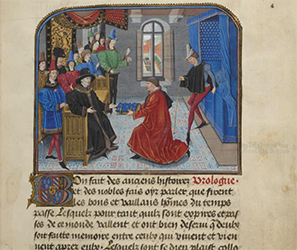 |
| Paris, Bibliothèque de l'Arsenal, ms. 5072, folio 4r: Renaud de Montauban. Presentation of the manuscript to Philip the Good. |
| Copenhagen, K.B., Thott 1090, 4o |
| Title: Le Débat (or La Controverse) de noblesse |
|
Translator: Jean Miélot |
| Scribe and Artist: Jean Miélot |
|
Commentary: Miélot was appointed as secretary by Philip the Good in 1449. He continued in this function under Charles the Bold. Ducal accounts record that one of his major functions was as a translator of texts from Latin into French, he translated some 30 treatises. In 1449, Miélot translated the De Nobilitate of the Italian humanist Buonaccorso da Pistoia for Philip th Good. The Latin text had been written in 1429 and dedicated to Carlo Malatesta of Rimini. The work is a debate before the Roman Senate between an idle man of noble birth, and an active Roman citizen of obscure and humble origin, for the hand of a lady. Here noblity of birth is set beside nobility of "virtue" as defined by a civic humanist of beginning of the early Renaissance. Miélot's position in this debate seems to be tipped in the presentation miniature. Here the Duke is wearing the armor associated with the old nobility and the preponderance of the figures in the miniature are representatives of the old nobility. The one figure who appears to represent the new nobility appears on the left side of the miniature. This figure's gesture of appeal to the duke is apparently blocked by the man next to him holding a large sword. A fight has broken out over a bone between the usually tranquil dogs lying at the feet of the duke in traditional presentation images. |
| Bibliography: Dogaer, 87-89; Vale, War and Chivalry,p, 21: C.C. Willard, "The Concept of true nobility at the Burgundian Court," Studies in the Renaissance, 14 (1967), pp. 33-48; Baron, The Crisis of the Early Italian Renaissance, pp. 420-3. |
| Brussels, Bibliothèque royale, ms. 9017, fol. 38V |
| Text: Composition de la Sainte Ecriture |
| Artist: Master of Girart de Roussillon |
| Commentary: presentation miniature is loosely based on the frontispiece of the Chroniques de Hainaut. |
| Bibliography: Dogaer, p. 82. |
|
Vienna,
Ö.N. B. , Cod. 2549, fol. 6
|
| Text: Roman de Girart de Roussillon |
| Date: in May of 1447, Josse Hanotiau delivered in Bruges plusieurs quayers of a translation of Gérard de Roussillon "avant quil fuissent en parcemin |
| Artist: Master of Girart de Roussillon (this is the eponymous manuscript) |
| Bibliography: Dogaer, pp. 15,63, 77, 82. |
| Paris, Bibliothèque nationale, MS. f.22547, fol. 1 |
| Title: Quintus Curtius, Livre des fais d'Alexandre le grant |
| Translator: Vasco da Lucena |
| Artist: Loyset Liédet |
| Date: c. 1468-79 |
Commentary: In 1468 the Portuguese humanist Vasco da Lucena completed his translation of a history of Alexander the Great by the ancient writer Quintus Curtius Rufus. Charles's mother, Isabella of Portugal was the patron of Lucena. The text reflects the dynastic ambitions of Charles and his father. In November 1470 Loyset Liédet was paid for eighty-six miniatures ("74 grandes et 12 petites") and for the decorated letters, a damask binding, a white leather case, and delivery to Hesdin. Antoine de Schryver identified this inventory entry with the Paris manuscript. The arms of Charles the Bold appear in the initial beneath the presentation miniature. |
Bibliography: Marina Belozerskaya, Rethinking the Renaissance: Burgundian Arts Across Europe, Cambridge, 2002; Antoine de Schryver, "Prix de l'enluminure et codicologie: Le Point comme unité de calcul de l'enlumineur dans "Le Songe du viel pellerin" et "Les Faictz et gestes d'Alexandre," In Miscellanea Codicologica F, Masai MCMLXXIX, edited by Pierre Cockshaw, Monique-Cécile
Garand, and Pierre Jodogne, vol. 2: 469-79, Ghent 1979; Illuminating the Renaissance, pp. 227-229, no. 54; Scot McKendrick, "Illustrated Manuscripts of Vasco da Lucena's Translation of Curtius's Historiae Alexandri Magni: Nature Corrupted by Fortune?" In Medieval Manuscripts of the Latin Classics: Production and Use. Proceedings of the Seminar in the History of the Book to 1500, Leiden, 1993: 131-49. Los Altos Hills, Ca. 1996. |
| Brussels, Bibliothèque royale, ms. 9043, f. 2 |
| Title: Aegidius Romanus, De regimine principium translated by Wauquelin, Le Livre du gouvernement des princes. |
| Scribe: Jacquemart Pilavaine of Mons was paid in 1452 for work on the manuscript by Philip the Good. |
| Artist: Master of the Privileges of Ghent and Flanders |
| Date: 1452 |
| Bibliography: Dogaer, pp. 15, 57, 59, 61, 63 |
| London, British Library, Add. Ms. 36619, fol 5 |
| Title: Military Ordinance of Charles the Bold |
Date: 1475, Bruges |
| Artist: Master of Fitzwilliam 268. possibly Philippe de Mazerolles |
Illuminating the Renaissance, no. 64, p. 252-53: In August 1475 Charles the Bold paid for twenty-one copies of his military ordinances of 1473. His valet de chambre and illuminator, Philippe de Mazerolles, was paid for both the script and the illumination. One volume, called "the original" was embellished with a large and expensive miniature and a fine box to house the appended seal of Charles. The present volume has been identified as that volume and thereby as Charles's own copy of the ordinances. Moreover, its miniature has been considered by de Schryver to be a documented work of the illuminator Philippe de Mazerolles. It is clear, however, that several different hands were responsible for both the writing and the illumination of the six surviving copies; thus Mazerolles was clearly paid for work undertaken by others. Bodo Brinkman has accordingly attributed the miniature in the present copy to the Master of Fitzwilliam 268. The opening miniature is a tour de force. The overall composition is based on the same model of authority used by contemporary illuminators to portray Charles as head of the Order of the Golden Fleece. In its detail, however, it also offers an exemplification of the installation of Charles's military captains. Seated on Charles's right are knights of the Order of the Golden Fleece; on his left are lay and clerical members of his council; in the foreground, facing Charles, stand twenty unarmed captains. In the middle an additional two captains receive copies of the ordinances, and another his baton. Clearly, this image is not a photographic record, but a formal template for the ceremony. Like the content of the text, it forms a ducal ordonnance. Given its importance, the duke's own illuminator must have been closely involved in the formalization of this image. |
| Brussel, Bibliothèque royale, Ms. 9028 |
| Guillaume Fillastre, Histoire de la Toison d'Or |
Commentary: The miniature shows Charles the Bold presiding over the Chapter of the Order of the Golden Fleece with the bishop Guillaume Fillastre appearing at the bottom. Born about 1400, Fillastre became in 1460 the bishop of Tournai and the chancellor of the Order of the Golden Fleece. Fillastre wrote his history of the order between 1468 and 1473. A number of copies of the text were made for the different members. They regularly have the same formulaic frontispiece to Book II representing the 1473 Chapter during which Fillastre presented his Histoire to Charles the Bold who had requested the text at the 1468 meeting. The miniature shows Charles seated under a blue cloth of honor embroidered with his arms. Members of the order wearing the Order's collar and scarlet robes flank the Duke. Fillastre in the robes of the bishop of Tournai stands in the foreground. |
| Bibliography: Charles le Téméraire, p.90, no. 11a |
| Paris, Bibliothèque de l'Arsenal, Ms. 5104 |
| Guillebert de Lannoy, L'Instruction d'un jeune prince and Enseignements paternels. |
| Artist: Jean Hennecart |
| Date: 1468-70. |
Commentary: Jean Hennecart was paid by Charles the Bold for illuminating two small books, each containing L'Instruction de josne prince. The Aresenal manuscript conforms exactly to the Burgundian account record. The appearance of the arms of Margaret of York along with the duke's, indicates a date after 1468, the year of their marriage. Guillebert de Lannoy was from one of the most prominent noble families and he was a counsellor of Philip the Good and a member of the Order of the Golden Fleece. The book belongs to the genre of text known as advice books. In it he lays out the code of conduct of a good prince. The text is set in the context of ancient Norway when the dying king asks his trusted counselor Foliant de Ionnal to write a book of instructions for his son Rudolph. The parallels between the King of Norway and his son and Philip the Good and Charles the Bold were certainly not lost. This is made even more explicit by the miniatures added to the Arsenal manuscript. Elements of each of the three miniatures are based on the Chroniques de Hainaut frontispiece. In the death bed scene on folio 5, the group of courtiers on the right are closely based on the courtiers on the right hand side of the Chroniques frontispiece. The sleeping dog in the foreground of the Arsenal miniature is also derived from the Chroniques miniature. The Wauquelin / Nockart figure offering the volume to Philip the Good in the Chroniques frontispiece is the source for the figure of Foliant de Ionnal in the miniature on folio 14 of the Arsenal book. In the miniature introducing the Enseignements paternels, the group on the left including the father are clearly based on the left hand side of the Chroniques composition. |
| Bibliography: Illuminating the Renaissance, pp. 234-237, no. 56. |
Compare to the spaces of the frontispiece of Paris, Bibliothèque nationale, fr. 331 also by Lieven von Lathem (illustrated above).
